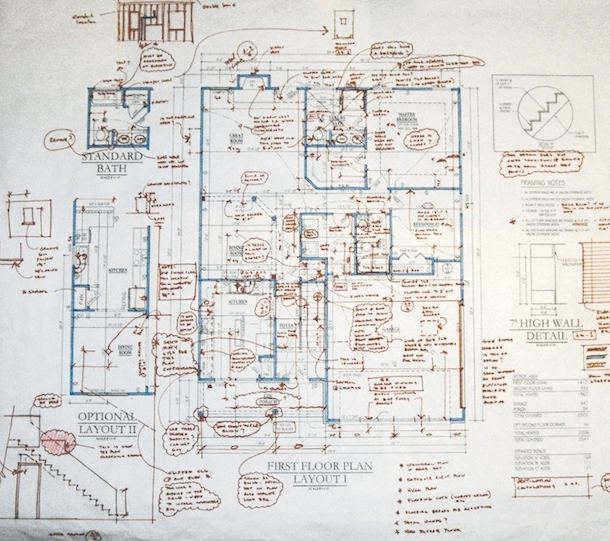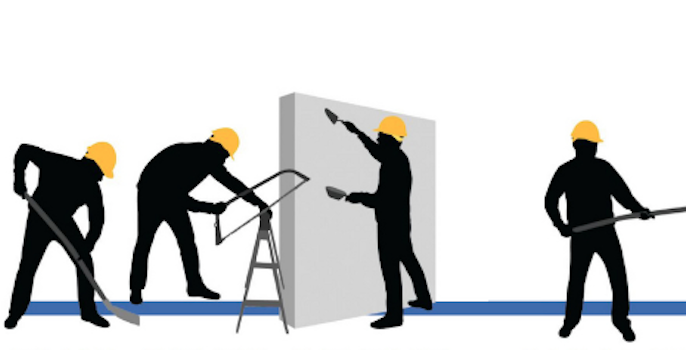Last month while traveling through a southern city, a time slot opened up unexpectedly, so I emailed an old client suggesting we meet the following day, catch up, and discuss his 2014 plans. The next morning as I finished my first appointment a text popped up from Rick, the company president, “Can you be here at 11:00? Important field construction meeting!” Evidently there was something he wanted me to see. If I left immediately I could just make it and, besides, the site was close to my next meeting.
I arrived at 10:55 to find Rick speaking to a large group that included everyone from construction, purchasing, and warranty along with the entire management team. He was pretty worked up, telling them how critical it was in their market to become the “Builder of Choice” for the best suppliers and trade contractors. Rick admitted that was something they had not achieved, and the trade shortage had now reached epidemic proportions. He smacked his hand in his fist, proclaiming that their schedule was suffering, costs were rising and, without a change, cash flow would become a serious problem. Just when he was getting really wound up, Rick turned to me and said in front of the crowd of 50 plus, “And now I would like our old friend and consultant Scott Sedam to give us some input on this.”
I was taken aback, thinking Rick did not even know I had arrived. As I walked to the front, my mind raced with thoughts, examples, war stories, what works and what doesn’t work on the subject of trade shortages. I had written multiple articles on various aspects of the problem, including one recently on the industry’s refusal to engage in grass-roots trade development. As Rick shook my hand, he whispered, “About 10 minutes.” What could I tell this eager but frustrated group in 10 minutes that would alleviate a nationwide epidemic?
My strategy was to empower them, to help the superintendents, construction managers, and purchasing staff believe the trade shortage problem was actually solvable. So I asked a simple question that initially confounds people, “What percentage of the trade base in this market do you use?” I got nothing back but quizzical looks. I asked again to let it sink in. Then after a moment, I asked, “What percentage of your market do you have?” This was a fair-sized builder in a top-10 U.S. market but still, the math came to only about 2 percent. Next question, “So if you build 2 percent of the market, you use what percent of the trade base?” Out of the confusion in the room finally came an understanding of the obvious answer—2 percent.
I then noted that we are in the midst of a nationwide trade shortage, which will get nothing but worse very soon. Industry growth was up 16 percent last year, immigration bills are stalled, and tradesmen who left construction are reluctant to return. I asked one more question, “So if you need 2 percent of the trades in your market, what does that tell you?” Now they were stymied and perhaps you, the reader, are as well. I ask you as I asked my group that day to ponder that question for a moment before we move on, because the implications are both huge and empowering.
To simplify the example, let’s say you, too, build 2 percent of the homes in your market and there are 100 electrical contractors. Let’s say 20 percent of them just cannot cut it, quality-wise. Another 20 percent can’t meet your schedule and/or volume. Still another 20 percent price themselves out of consideration. Finally, 20 percent more just can’t do business the way you do in terms of systems and process. That leaves you 20 percent left to consider; 20 electrical contractors who have genuine potential. Consider that if you build only 2 percent of the market, you need only two of the 20 who made the cut. That means there are 10 good electrical contractors for every one you need. That is what the late Stephen Covey called “a world of abundance” even in times like these. The ultimate query thus becomes, can you get one of those 10? Surely, you are good enough to get one? But the real goal is to be so good that all of those 10 want to work with you. Achieve that and you still have options and control, even during a shortage, and I know builders—just a few—who have done it.
When It Comes to Trades, Change the Question
So how do you achieve it? For starters, I refer you back to two articles previously published in
Professional Builder: “
10 Strategies for Managing the Coming Labor Shortage,” and “
The 10-Step Labor Shortage Immunization Plan for Builders.” Let’s think a bit about what trades want and note that this applies to your supplier base as well. Most will immediately respond, “More money!” That is not only wrong, it is the very obstacle getting in our way. Your trades do not need more money, they need more profit. That’s not mere semantics. Behaviorally, it’s a genuine paradigm change requiring significant transformation in thinking to get your brains around it.
So let’s change the question to one that will set you on an entirely new path. “How do you help your trades become more profitable, so that you become more profitable?” I fully expect that to feel a bit uncomfortable at first, and if you truly believe building is a zero-sum game, then it’s doubtful I or anyone else can help you. You’ve come this far, though, so let’s try an example.
Joe, a Chicago-based electrician, has developed a strong reputation for high quality at a reasonable price, having good people, working and playing well with others, keeping sites clean, and staying on schedule. Joe had worked for years with a strong local builder that sold out to a national. Most of the original employees were gone within a year and the builder hired replacements from near and far. With deep pockets and a strong market, the operation was soon big enough to warrant two construction managers, one North Side and another South Side. Joe quickly realized that working the North and South sides meant two very different things. The product was the same, but the similarity ended there. When the next round of bids came up, Joe told purchasing he would only bid on the North Side projects. He explained that he made money on the North Side and lost money on the South Side. Take a minute and consider how that could be.
I asked this of the group and, at first, they targeted the usual suspects. The southern projects were farther away? No. There were more options in the south than the north? No, again. Finally, someone hit the big kahuna—schedule. The construction manager in the north was a veritable madman about schedule. Joe’s shop was actually located to the south, but the schedule was so bad down there, he actually traveled more miles per unit on the southern houses, which averaged twice the number of trips to complete. The north ran like clockwork. Jobsites were clean and both HVAC and plumbing were out when Joe’s crews arrived. The light fixtures were always ordered correctly for the northern units as well. The field superintendents were knowledgeable, and they got along with the inspectors, with virtually no yellow tags, red tags, or delayed inspections costing extra days. In the south, it was the opposite. Trades on top of each other; site is a mess; fixtures ordered wrong; and drywallers covering up outlets. There were red tags, yellow tags, and delayed inspections, plus the plumber refused to hook up the pigtails on the hot water heater, necessitating an additional trip.
It got so bad that Joe had to pay a guy to check every southern house to see if it was ready before he sent out a crew. When Joe brought these problems up with the North Side construction manager, the reply was, “That guy and I came from two very different companies with two opposite philosophies. Where I came from, schedule was everything and everyone in the company from sales to purchasing to construction was committed to doing their part to keep it on track. As a result, we got the best trades and the best crews. It’s harder here, for sure, but my guys know it’s job one. My counterpart down south just doesn’t get it. He’s thinking if he could just get his 90-decibel mouth to 100, he’d solve the problem.”
Joe finally agreed to do them all for a 5 percent overall raise, but neither he nor purchasing was happy. A better route would be the builder’s resolution to bring the entire operation up to the North Side’s standards. How many suppliers and trades would actually agree to work for a lower bid price if they knew they’d make more profit? The trades do better; the builder reduces cost, and the customer gets a better home. Everyone wins.

A builder's "dialed-in" plan (with input from 25 suppliers and trades).
I have a computer full of examples, and the picture here is one of my favorites. The marked-up plan shown above (used with permission) is a house the builder—a very good one—had been constructing for a number of years and believed to be quite well “dialed in.” Starting with a clean sheet on Monday morning, this is how the main floorplan appeared by Wednesday afternoon, after 25 suppliers and trades brought in all of their ideas for improvement during one of our LeanWeek sessions. If you blew the picture up, you would find the number “137” labeled on one idea—the total number of improvements suggested. Some ideas are simple things like missing dimensions that require phone calls to clarify. Another is a conflict in door openings that aggravated customers. Another is a cabinet layout requiring extra filler pieces that could be easily resolved. Still another is a conflict with HVAC duct routing due to the roof-truss layout that caused significant rerouting and compromised efficiency. Still 133 to go … but you get the picture. If a builder was to resolve all of these issues, how much time, frustration, and money would be saved for everyone? And which builder do the suppliers and trades want to work for? How about the one who puts out fully detailed site-specific plans with all required specifications, right the first time, ready to build. And here’s a bonus: The trades actually build the same house they bid on. All of this equates to profit.
How to Get the Best Suppliers and Trades
We are just getting started, and there are many other opportunities for attracting the best suppliers and trades besides merely paying more. Most obvious, and so often abused, is paying quickly and always on time. You say you pay monthly but often let that slip to 60 days or worse? After working with more than 3,500 suppliers and trades in our LeanWeek sessions, I can guarantee you that any nickel you believe you save on the float is burned up five times over in response time, schedule, and warranty. Do what you have to do to get caught up. Thirty days without fail is barely table stakes in this market. The smart builders pay twice a month or even weekly. One of the best, DSLD Homes, pays twice a week. Each week, your suppliers and trades have to decide where to send their crews and more importantly their best crews. Where will they send them and at what price? To the builder who pays them now, or the one who pays them later? What would you do?
You also need to think hard about what you are willing to pay for. Would you consider accepting a higher bid price for a trade with better, well-trained crews that deliver consistent quality, stay on schedule, and keep the sites clean? If the total cost is lower, why wouldn’t you? How about two framers who bid a project the same, and one has a state worker compensation factor of 0.8 while the other sports a 1.2. You do look at those factors, don’t you? What do they tell you about the trade, other than that the former is safer and pays 50 percent less for insurance than the latter? Should you recognize these trades with your pay scale? You would if you knew the true economic value. What do you care about, bid price or profit? No different than your trades.
I wrote those two articles I cited earlier in 2012 before the trade shortage hit hard. This January, I wrote another one about how the industry is
doing virtually nothing about the lack of trade education and development in this country. Despite that, there are very practical steps to take that will improve your trade position significantly. Of course, that all depends on the fact that 95 percent of your competitors will not be thinking at your level. Count on it.
If you would like a single PDF of all of Scott Sedam’s articles on solving the trade shortage, please email your request to scott@truen.com with the words “Trade Shortage PDF” in the subject line.









